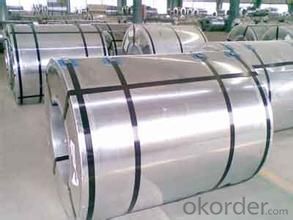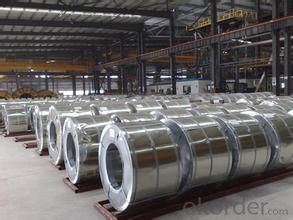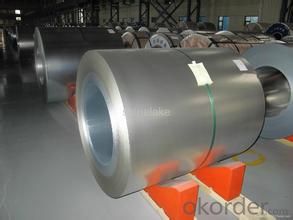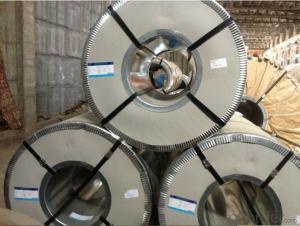Galvanized Steel Coil / Galvanized Steel Sheet
- Loading Port:
- China Main Port
- Payment Terms:
- TT or LC
- Min Order Qty:
- -
- Supply Capability:
- -
OKorder Service Pledge
OKorder Financial Service
You Might Also Like
Specifications
Galvanized steel coil
1.Size:0.1-7.0x600-1500xC
2.ID:508mm/610mm
3.Standard:JIS G3302 ASTM A653
4.Zinc coating:40-275G
galvanized steel coil
| product name | Galvanized steel coil |
| thickness | 0.1mm-7.0mm |
| width | 600mm-1500mm 762mm,914mm,1000mm,1200mm,1219mm,1250mm |
| zinc coating | 40g-275g 40g, 60g, 80g, 100g, 120g, 140g,180g, 200g, 250g, 275g |
| standard | ASTM, AISI, DIN, GB |
| material | SGCC,DC51D,DX51D,DX52D,,SGCD,Q195,Q235,SGHC,DX54D, S350 GD, S450 GD,S550 GD |
| spangle | zero spangle, regular spangle or normal spangle |
| surface treatment | chromated and oiled, chromated and non-oiled |
| packing | export standard. |
| payment | T/T or L/C |
| min order | 1 tons |
coil weight | 6-8ton or as client requirement |
quality | soft or hard quality |
Galvanized Steel Coil
| STEEL GRADE | CHEMICAL COMPOSITION % | MECHANIC PROPERTY | C.B OF COATING | COATING | ||||||
| C | Si | Mn | S | P | T.S | Y.S | E.L | |||
| x103 | x103 | x102 | x103 | x103 | Mpa | Mpa | % | d=0 180° | G/M² | |
| JIS G3302 SGCC | 12 | 30 | 41 | 31 | 21 | 480 | 300 | 13 | OK | Z60-150 |
| JIS G3302 SGCH | 12 | 10 | 21 | 18 | 8 | 680 | 650 | OK | Z60-150 | |
| ASTM A653 CS.B | 20 | 30 | 60 | 35 | 30 | 386 | 205~380 | 20 | OK | Z80-275 |
| DX51D+Z | 29 | 21 | 18 | 1.8 | 11 | 355 | 245 | 38 | OK | Z80-275 |
| G550 | 20 | 6 | 73 | 5 | 17 | 715 | 654 | 8 | OK | Z80-275 |
(1) Coil ID: 508/610mm, Coil weight: 3-8Ton
(2) Top coating 15-25um, back coating 5-15um, RAL international color
(3) With/Without PE film, Smooth/Matt finish
FAQ of Galvanized Steel Coil / Galvanized Steel Sheet:
①How is the quality of your products?
Our products are manufactured strictly according to national and internaional standard.Guaranteed: If products’ quality don’t accord to discription as we give or the promise before you place order, we promise 100% refund.
②How about price?
Yes, we are factory and be able to give you lowest price below market one, and we have a policy that “ for saving time and absolutely honest business attitude, we quote as lowest as possible for any customer, and discount can be given according to quantity”,if you like bargain and factory price is not low enough as you think, just don’t waste your time.Please trust the quotation we would give you, it is professional one.
③Why should you chose us?
Chose happens because of quality, then price, We can give you both.Additionally, we can also offer professional products inquiry, products knowledge train(for agents), smooth goods delivery, exellent customer solution proposals.Our service formula: good quality+good price+good service=customer’s trust
SGS test is available, customer inspection before shipping is welcome, third party inspection is no problem.
Any question, pls feel free to contact us !
Galvanized Steel Coil / Galvanized Steel Sheet Images:



- Q:How are steel coils used in the manufacturing of construction equipment?
- Steel coils are used in the manufacturing of construction equipment as they provide a strong and durable material for various components. These coils are shaped and processed into different parts, such as frames, chassis, and reinforcements, which enhance the structural integrity and overall performance of construction machinery.
- Q:I just bought a dpms ar15 and it says if I shoot steel cases (laquer coated) or foreign ammo it voids the warranty. But before I knew this I bought 200 rounds of Russian steel cased anmo. Think I should just shoot there two hundred and not buy anymore? Some people say all they shoot is steel cased ammo and have no problemAny advice is appreciated
- I would probably buy a box of 20 brass cased ones and shoot them first to see that the gun works if you really believe that steel cased/foreign ammo voids the warranty. That way you will know that the rifle is functional from the factory. My son has a Rem 700 SPS Varmint that has only fired handloads and there are a couple of other rifles that have never had a factory round in them and the manufacturers claim that hand loads void warranties too.
- Q:How are steel coils protected during shipping?
- Various measures are implemented to safeguard steel coils during shipping, guaranteeing their safety and preventing any harm. One widely used technique is the utilization of steel coil cradles or saddles. These structures, specifically designed for this purpose, securely hold the coils in place and prevent any movement or rolling during transit. Typically made from robust steel or durable materials, the cradles are engineered to withstand the weight and pressure of the coils. Additionally, steel coils are often wrapped in protective materials like plastic or paper. This wrapping acts as a barrier, shielding the coils from potential contaminants such as moisture, dust, and other detrimental factors that could compromise their quality. The wrapping is applied tightly to ensure it remains in position throughout the entire shipping process. To provide further protection, specialized equipment is used to load the coils into shipping containers or onto flatbed trucks. Coil hooks or lifting clamps are examples of such equipment, allowing for safe and secure handling, thereby minimizing the risk of accidents or damage during the loading and unloading stages. In certain cases, steel coils may be packed into wooden or metal crates to offer additional safeguarding. These crates serve as an extra layer of security and prevent any potential impacts or rough handling from causing damage to the coils. Ensuring the protection of steel coils during shipping is of utmost importance to ensure their arrival at the intended destination in optimal condition. By employing cradles, protective wrapping, specialized equipment, and additional packaging when necessary, the risk of damage is significantly reduced, resulting in a smooth and successful transportation process.
- Q:What material is strongest? Human bone, steel, or concrete?
- Steel is used to shape and reinforce concrete. Steel is also used in cutting bones in surgery and repairing bone through use of steel pins and braces. So, the answer is most definitely steel. In answer to your watch question, the volume of concrete was greater than that of your watch. The question of large volume vs. small volume is an easy one. Ten tons of human bone would easily reduce a 1 lb block of concrete to powder. Likewise, ten tons of concrete would snap a steel bar like a toothpick. Your watch had much less volume than the concrete you dropped it on. Furthermore, with enough force, your watch would have made a hole in the concrete, but its acceleration was not enough to counter the impacting force of the solid concrete reinforced by the soil and clay below it.
- Q:What are the uses of galvanized steel coils?
- Galvanized steel coils are widely used in various industries for their durability and corrosion resistance. They are commonly used in construction for roofing, siding, and structural components. They are also used in the automotive industry for manufacturing parts such as body panels, chassis, and exhaust systems. Additionally, galvanized steel coils find applications in the manufacturing of appliances, agricultural equipment, and electrical enclosures.
- Q:What are the major global steel coil markets?
- The major global steel coil markets include countries such as China, the United States, India, Japan, Germany, South Korea, and Russia, among others. These countries have a significant demand for steel coil due to their large manufacturing and construction sectors.
- Q:What is the difference between hot-rolled and cold-rolled steel coils?
- Hot-rolled steel coils are produced by heating the steel above its recrystallization temperature, resulting in a more malleable and less precise product. On the other hand, cold-rolled steel coils are processed at room temperature, yielding a stronger, more precise, and smoother finish.
- Q:What are the different methods of coil leveling?
- There are several methods of coil leveling that are commonly used in various industries. These methods include: 1. Roller leveling: This method involves passing the coil through a series of rollers that apply pressure and gradually flatten the coil. The rollers can be adjusted to apply varying levels of pressure, allowing for precise control over the leveling process. 2. Stretch leveling: In this method, the coil is subjected to tension forces that elongate the material and remove the internal stresses. The coil is passed through a series of rollers while being stretched, which results in a more uniform and flat surface. 3. Temper leveling: This method involves heating the coil to a specific temperature and then cooling it rapidly. The rapid cooling process helps to equalize the stresses within the coil and improve its flatness. Temper leveling is often used for high-strength steels. 4. Roller leveling with leveling rolls: This method uses additional leveling rolls that are positioned above and below the main leveling rollers. The leveling rolls apply pressure to specific areas of the coil to correct any unevenness or distortions. 5. Tension leveling: This method involves applying tension to the coil while it is being processed. The tension helps to straighten and flatten the material, resulting in a more even and flat surface. 6. Precision leveling: This method is used for high-precision applications where extremely flat and uniform coils are required. Precision leveling involves a combination of roller leveling, stretch leveling, and other corrective measures to achieve the desired level of flatness. Each of these methods has its own advantages and limitations, and the choice of method depends on factors such as the type of material being leveled, the required flatness tolerance, and the intended application of the coil.
- Q:does regular steel rust? or is it all the same.
- There are dozens of types of steels, some stainless and some not. They differ a lot in their chemical composition and in how they're made (especially heat treating methods). They all vary in their strength, working properties and corrosion resistance. Regular steel (technically carbon steel--mostly iron, with a little bit of carbon) rusts quite badly if unprotected and in the right environmental conditions i.e. humidity/moisture. The iron in regular steel reacts with oxygen to form iron oxide--the orange/red stuff we call rust. Iron oxide is a loose and porous material which provides no protection to the underlying steel, which is why rusted regular steel will continue to rust. Stainless steel, in addition to containing iron and carbon, contains chromium as a component--and it's the chromium that is important for corrosion protection. To be fair, even stainless steel rusts but what happens is that it's the chromium that reacts with oxygen to create a microscopically-thin layer of chromium oxide. This layer is very tough and actually protects the uncorroded steel, preventing further corrosion. Broadly speaking, the higher the chromium content, the more corrosion resistant the stainless steel.
- Q:I'm talking about the sort of carbon fiber that's used in the auto industry (mostly in supercars).If an object made of steel were to be copied by an exact same object, but made of carbon fiber - how lighter would the carbon fiber object be?For example, if a table is made of steel and it weighs X, how much will it weigh if it were made of carbon fiber?Thanks.
- In most applications, you do not want to make the graphite fiber composite object the same size as the steel object. You want it to have the same strength. So... the benefit of using the composite is not just the difference in density. What you really want to compare is the specific strength and you can define this slightly differently depending on your application. As a simple example, suppose you need to hang a weight of 100 pounds from a beam with a bar (so the load is pure tension) and not have the weight permanently stretch the bar (so stress in the bar is less than the yield stress). You can calculate the cross sectional area of steel and compare that to the cross sectional area of the graphite fiber composite required. If your application is more complicated, say it has to support the load and flex up to 10 degrees and survive some impact loading and operate at a max temperature of 200C, then you have more homework to do to select the best material. And... if you are not rich enough so that money is no object, you also need to consider the cost.
1. Manufacturer Overview |
|
|---|---|
| Location | |
| Year Established | |
| Annual Output Value | |
| Main Markets | |
| Company Certifications | |
2. Manufacturer Certificates |
|
|---|---|
| a) Certification Name | |
| Range | |
| Reference | |
| Validity Period | |
3. Manufacturer Capability |
|
|---|---|
| a)Trade Capacity | |
| Nearest Port | |
| Export Percentage | |
| No.of Employees in Trade Department | |
| Language Spoken: | |
| b)Factory Information | |
| Factory Size: | |
| No. of Production Lines | |
| Contract Manufacturing | |
| Product Price Range | |
Send your message to us
Galvanized Steel Coil / Galvanized Steel Sheet
- Loading Port:
- China Main Port
- Payment Terms:
- TT or LC
- Min Order Qty:
- -
- Supply Capability:
- -
OKorder Service Pledge
OKorder Financial Service
Similar products
New products
Hot products
Related keywords




























